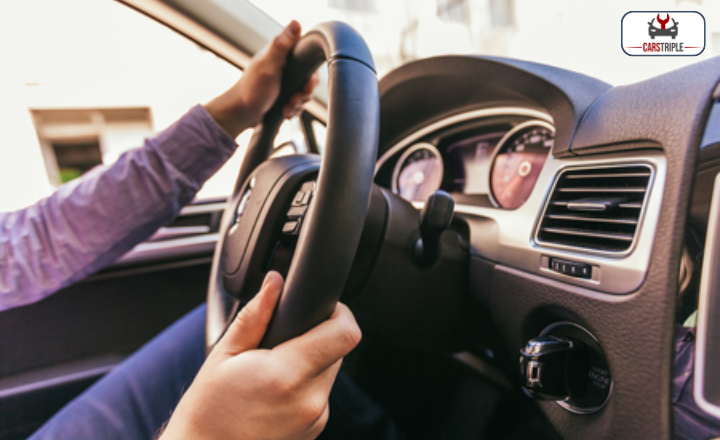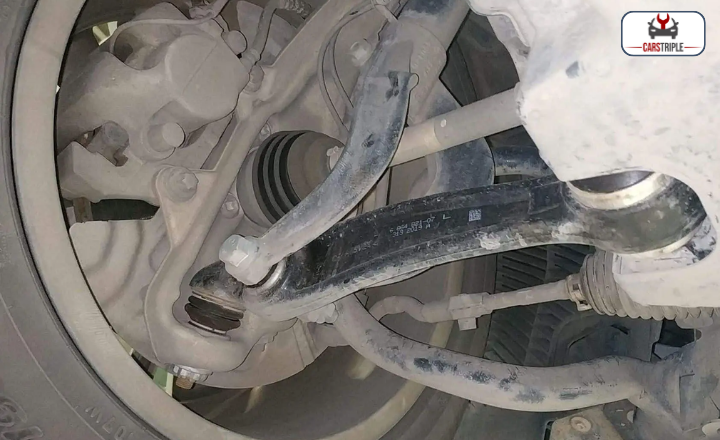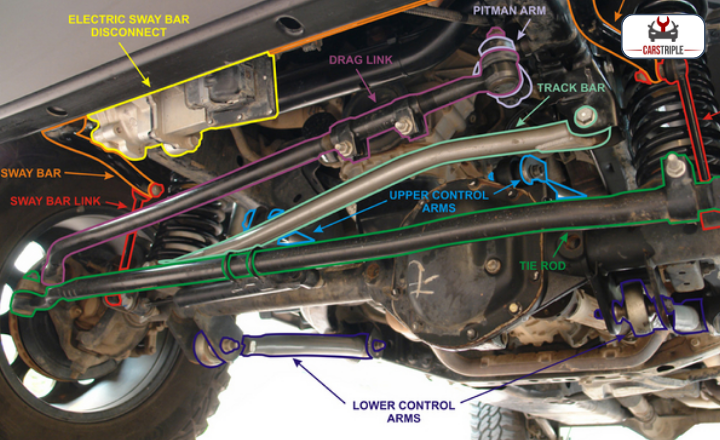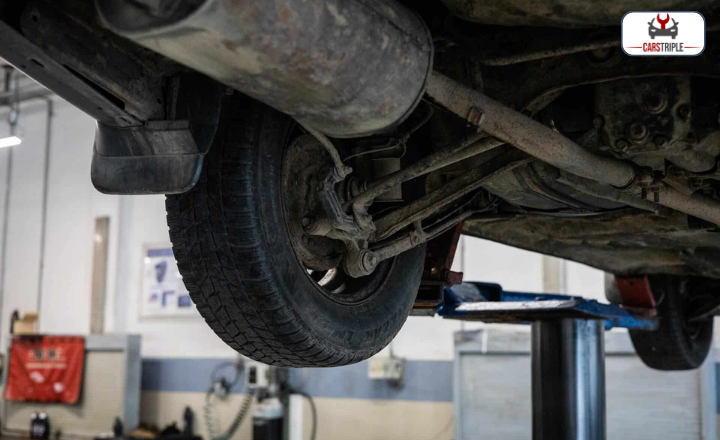The steering and suspension systems of a car have really important parts that are often overlooked. These parts make sure that your journeys are safe and that your vehicle works well. It’s important to keep each part in good condition so they work properly. The control arms of a car are some of the most expensive steering and suspension parts. They connect the front wheels to the frame mounts.
This article will take a closer look at the control arm on a car. We’ll discuss what they do, how they function, and what happens when they’re not working properly. By the end of this article, you’ll have the knowledge to recognize and fix any issues with your car’s control arms so that it runs smoothly and steadily.
What Is A Control Arm On A Car?
A control arm is a crucial part of a car’s steering and suspension system. It connects the vehicle’s frame to the hub of the wheel, allowing the front wheel to move up and down in response to the car’s movement. Inside the control arm are bushings that help reduce wear from constant motion, while shocks and struts help soften this movement for a smoother ride.
In trucks and SUVs, there are upper and lower control arms that work together to support the weight of the vehicle. Some cars may only have lower control arms. The dimensions of control arms can vary between different vehicle types, but they all play a key role in maintaining stability and smoothness in the car’s handling and ride quality.
5 Bad Control Arm Symptoms
Defective control arms often show various additional signs, some of which are more obvious than others. Recognizing these indicators can be very helpful in diagnosing the problem.
Unreasonable vibration
Excessive vibration in a car can often be a sign of a worn-out control arm or faulty motor mounts. If you’re feeling a constant shudder or shimmy, especially at higher speeds, it could be a clue that your control arm needs attention. As the wear on the control arm increases, the vibration may also get worse, so it’s important to address this issue promptly to avoid further damage.
Excessive shaking or vibration could also indicate problems with the motor mounts. These are components that support and align the engine in the vehicle, and if they become faulty, they can cause noticeable vibrations throughout the car.
Steering that is unresponsive or unstable

Unresponsive or unstable steering can be a sign of worn control arms in a car. Worn control arms can lead to sluggish steering and poor straight-line performance, affecting the overall handling and cornering capabilities of the vehicle. This can result in the need for more frequent steering corrections by the driver, impacting the car’s stability and safety.
Tire wear that isn’t even or regular
Uneven or irregular tire wear can be a clear sign of excessive control arm wear. This type of wear often appears around the inner or outer margins of the tread, rather than across the entire tread area. If left unaddressed, it can lead to premature tire replacement and unnecessary spending. It’s important to have your control arms inspected and replaced if necessary to avoid further tire wear issues.
Strange road noises
Strange noises such as popping, clicking, or metallic sounds from the front of your vehicle might mean that the control arm is worn out. These noises are often most noticeable when driving over bumps or uneven terrain and can resemble the sound of a failing CV joint.
It’s important to have your vehicle inspected by a mechanic to diagnose and address any potential issues with the control arms to ensure safe and smooth driving. Ignoring these strange road noises can lead to further damage and safety concerns, so it’s best to address them promptly.
Visual Damage
If you suspect your control arms are failing, it’s important to visually inspect them by lifting your car and examining the suspension of each wheel. If you notice any visual damage such as cracks, bends, or signs of wear, it’s necessary to replace the affected control arm. Failing to address damaged control arms can lead to compromised handling and safety issues while driving.
Can You Drive With A Bad Control Arm?
Driving with a bad control arm is not recommended and can be very dangerous. The control arm plays a crucial role in connecting the wheel ends and frames of a vehicle, so if it’s damaged or malfunctioning, it can affect the stability and handling of the car. This can lead to loss of control, uneven tire wear, and even potential accidents.

If a link in your vehicle’s steering system were to break while in use, it could lead to serious consequences. The steering would become unpredictable, making it difficult to control the vehicle, and there is a risk of an accident occurring at any speed if a control arm were to fail. Such failure could result in secondary damage to your vehicle and pose a risk to your safety.
Can Control Arms Cause “Death Wobble”?
Death wobble is a serious issue that can occur when there is excessive slack in the steering or suspension parts underneath the front end of a car. This can lead to intense shaking or swaying, which can be very alarming for passengers. It’s important to address any potential causes of death wobble, such as damaged control arms, deteriorated bushings, or loose mounting nuts, to ensure the safety and stability of the vehicle.
How A Control Arm Is Inspected?
Control arms and other suspension components can’t be thoroughly inspected at a drive-through fast-lube location. When these parts are not properly inspected, issues like an old ball joint or poor control arm bushings can go unnoticed. Signs that these components may be malfunctioning include hearing popping or clunking sounds when accelerating or going over bumps, feeling shaky or wandering while braking, and experiencing uneven handling on rough terrain.

It’s important to get your car checked by a qualified mechanic once a year when it’s lifted on a hoist at a garage. This will help identify any potential issues with the suspension components and fix them before they become bigger problems. Sometimes, you may not notice these symptoms, so it’s best to have a thorough inspection done regularly.
When Do The Control Arms Need To Be Replaced?
The front suspension of a car is made up of several essential components, and control arms are one of them. These control arms play a crucial role in maintaining the stability and smooth operation of the vehicle. When a control arm wears out or gets damaged, it can make the car unsafe to drive.

Control arms and other front-end parts have improved, but they can still fail. This means that local auto repair shops will still be needed, especially for electric cars with front-end issues. The lower control arms play a key role in the front suspension system of modern cars. They are connected to the sub frame or body using rubber bushings, which help absorb vibrations and reduce noise from the road.
These bushings also allow the control arm to move up and down as the car travels over bumps, providing flexibility and smoothness in the ride. It’s outer end is linked to the steering knuckle with a ball joint, which holds up the front wheel. This connection makes steering and maneuvering smooth. The stabilizer (sway) bar is connected to the lower control arms or struts, helping to keep the car stable when turning and improving safety and handling.
Control Arm Replacement Cost
The cost of replacing a control arm can vary widely depending on the make and model of your vehicle. This is because the price of the control arm itself and the labor hours needed for replacement can differ from car to car. The labor rates at different repair shops can also impact the overall cost.
You can expect to budget between $150 and $400 for replacing a single control arm, but in some cases, it may be more expensive. It’s important to shop around and get quotes from different mechanics or repair shops to find the best deal for your specific vehicle.
Is An Alignment Necessary After Replacement?
It’s important to get an alignment after replacing one or more control arms on your vehicle. The control arm can’t be adjusted for caster, camber, or toe, but it’s important to still get an alignment. This is because any impact that damaged the control arm might have also affected other front-end components. An alignment will ensure that everything is properly adjusted and working together, preventing uneven tire wear and maintaining steering stability.
The control arm might not need to be adjusted separately, but getting a proper alignment can help spot any problems caused by the impact that led to replacing the control arm. It’s like giving your car a check-up to make sure everything is in order after a significant event like a collision or hitting a pothole.
Conclusion
The control arm on a car is really important for the suspension system. It helps to keep the car stable and in control while driving. Recognizing signs of a bad control arm, like lots of shaking, tires wearing unevenly, and the steering wheel wobbling, is really important for keeping your car safe and avoiding more damage. Checking your control arms regularly can help find problems early and stop accidents or costly fixes. If you see any of these signs in your car, get a mechanic to check your control arms to make sure your car stays safe and works well. Don’t wait until it’s too late, act fast if you think there might be a problem with your control arms.
FAQ’s
What causes control arms to go bad?
Control arms can go bad due to wear and tear from regular use, exposure to harsh road conditions, or lack of proper maintenance.
How do I know if my control arms need replacing?
You may need to replace your control arms if you notice any of the symptoms mentioned above, or if there is visible damage or corrosion on the arms.
